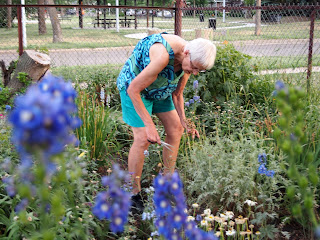It was another beautiful day for a field trip! Club members Audrey, Erica, Margaret, Marie, and I piled into Barry's vehicle and headed out to Lac St. Anne - only slightly breaking the law along the way.
We chatted about our gardens, ant control, and shared stories about outhouses. Before long we were at our destination:
George Pegg Botanic Garden.
It certainly was the best time to visit - there were no other groups there, and we found both raspberries and Saskatoon berries were in fruit - a very lovely breakfast / mid-morning snack!

Cassidy, our guide, was amused by our enthusiasm. We toured the historic homestead, paying particular attention to the different plants. There was wild sarsaparilla (
Aralia nudicaulis), amur cherry (
Prunus maackii), heritage tree ponderosa pine (
Pine ponderosa), poison ivy (
Rhus radicans - clearly fenced off), St.John's Wort and many more. An edible gardening area also featured different kinds of peas and apple trees. Wouldn't you know it? Someone started weeding the rose garden.
It's probably no surprise that with such plant diversity there would also be plenty of animals and insects: multiple bees heading straight for one flower, frogs, a mouse, and even bats!
Cassidy led us also through some educational activities in the barn, a "What can you compost?" exercise. You can bet there was a lot of discussion amongst our group.
More photos of our visit click here:
We left to find lunch and was pleasantly surprised by the cafe at Gunn Esso - real soup!

Next it was to Granola Greenhouses!
The owners greeted us and shared handfuls of Saskatoon berries from their stock. We got some great deals on interesting plants - so many in fact, we completely filled Barry's truck bed. And still we probably could have filled more...
What a great day!





















































